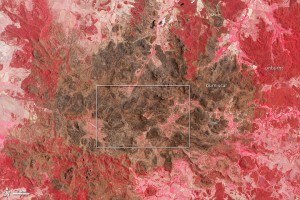On the afternoon of January 14, 2013, a fierce bushfire swept across the campus of Siding Spring Observatory, a world-class astronomy facility on a ridge in Australia’s Warrumbungle National Park. The observatory is home to some of the most powerful sky-mapping telescopes in the world.
Ten years earlier, a brush fire devastated one of Australia’s other top observatories, so the staff of Siding Spring feared that history was repeating itself. As the fire reached the observatory’s campus, cameras and telescopes sent back disturbing images of flames lapping at the doorsteps of buildings and smoke billowing overhead.
By nightfall on January 14, the situation looked dire to the scientists and staff who had evacuated and were left to monitor the situation online. A handful of buildings on the campus were on fire. At one point, a thermometer on campus recorded a spike in air temperatures to 100 degrees Celsius (212 degrees Fahrenheit).
Read full story at:
Earth Observatory, February 2013




